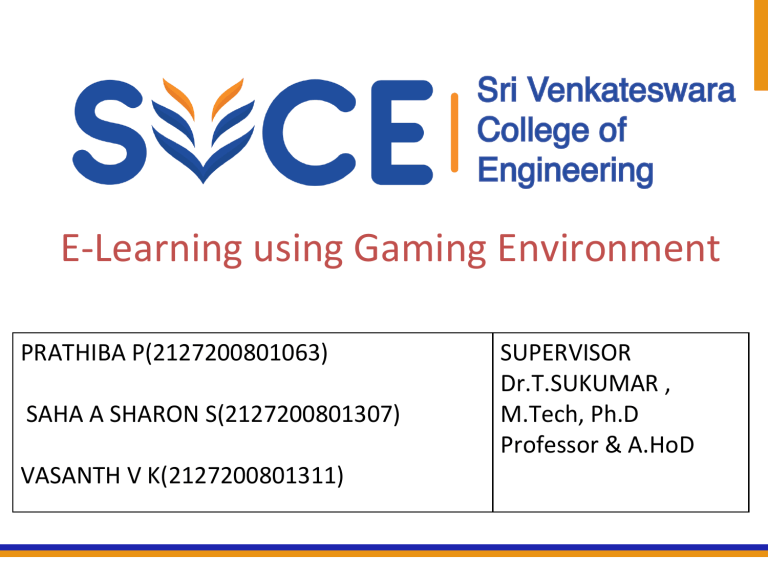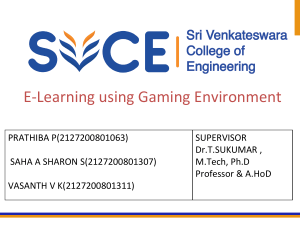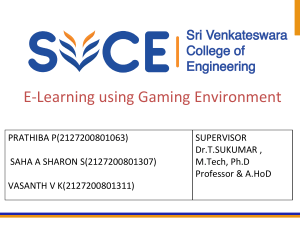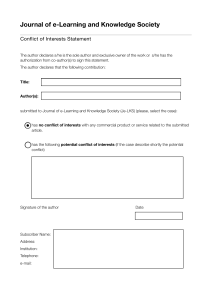
Title E-Learning using Gaming Environment PRATHIBA P(2127200801063) SAHA A SHARON S(2127200801307) VASANTH V K(2127200801311) SUPERVISOR Dr.T.SUKUMAR , M.Tech, Ph.D Professor & A.HoD Problem Statement • To bring Gamification on E-Learning to help the students get over the traditional methods of learning NEED & Motivation NEED • To enhance visual skills • To improve students interaction • To enable them to apply gaming values in a real-world situation by reducing the complexity in more approachable, inexpensive, efficient and comfortable way. MOTIVATION • To make the students accustomed to incorporate game elements and mechanisms to enhance the motivation, engagement and students learning. Novelty •Simplified E-Learning •Multi-device compatible with modular randomise questions and graphical content . •Online assessment. •Adaptive framework. Architecture OBJECTIVES 1. Engagement 2. Skill Development 3. Retention 4. Real-Life Application 5. Fun and Exploration 6. Rewards and Feedback 7. Assessment MODULE DETAILS MODULE 1 : User-Interface Navigation Module • User Profile Module : User authentication and login components. • User profile management, including user avatars, usernames, and settings Gaming Module (for game UIs): • Heads-up display (HUD) elements for game status, health, inventory, and scores. • Game-specific UI components like minimaps, quest logs, and character stats. MODULE DETAILS MODULE 2 : Learning modules Game UI Animations: • In game design, animations can be used for character movements, combat actions, special effects, and transitions between game states. Content Presentation: • The core instructional content, presented in a structured and organized manner. • May include text, images, videos, interactive simulations, and other multimedia elements. MODULE DETAILS MODULE 3 : Game-Engine Graphics Rendering Module: • Responsible for rendering 2D and 3D graphics • Supports various graphics APIs like DirectX, OpenGL, or Vulkan. Physics Engine Module: • Simulates physical interactions within the game, including collision detection, rigid body dynamics, and particle systems. Asset Management Module: • Manages game assets, such as textures, models, audio files, and scripts. • Includes asset loading, caching, and memory management. MODULE DETAILS MODULE 4 : Game – logic Game State Management: • Game logic tracks the current state of the game, including the level, score, health, inventory, and progress. Player Input Handling: • Game logic processes player input, including keyboard, mouse, controller, touch, or other input methods. Win/Lose Conditions: • The game logic determines the criteria for winning or losing the game, leading to outcomes like victory, defeat, or progression to the next level. Game Rules and Mechanics: • It enforces the rules and mechanics specific to the game, including scoring, health, inventory management, and power-ups. MODULE DETAILS • MODULE 5 : Assets Character and NPC Models: Character models represent playable characters and non-playable characters (NPCs) in the game. They include their appearance and animations. Cut scenes and Cinematic: These assets consist of scripted sequences and animations that advance the game's narrative and storytelling. 3D Models: These are 3-dimensional objects used to represent characters, props, and environments in 3D games. They can be characters, weapons, buildings, or any other 3D objects within the game. 2D Sprites: 2D sprites are 2D images or animations used for characters, objects, or special effects in 2D games or 2D elements within a 3D game. • MODULE 6 : Data-Storage Object Storage: Object storage is a data storage architecture that uses a flat address space for storing and retrieving data as objects. Data Compression: Data compression techniques are used to reduce the size of data files, saving storage space and bandwidth. Latency: Latency refers to the time it takes to access data. Low-latency storage is essential for real-time applications, such as gaming . RESULTS • • • • • • • • Increased Engagement Higher Motivation Improved Retention Enhanced Problem-Solving Skills Personalized Learning Paths Data-Driven Insights Lifelong Learning Skills Transfer and Cost-Effective Training PERFORMANCE EVALUATION • • • • • • • • Clear Learning Objectives Gamified Assessments Points and Rewards Progression Systems Storytelling and Narrative Analytics and Data Tracking Feedback Surveys Continuous Improvement GANTT CHART ACTION PLAN : AUGUST Activity Literature survey UserInterface Learning Modules (animated –video) Testing using Gaming Environm ent Leveling – up W1 W2 W3 SEPTEMBER W4 W5 W6 W7 OCTOBER W8 W9 W10 W11 NOVEMBER W12 W13 W14 W15 W16 PO’S and PSO ‘s addressed • PROGRAM OUTCOME (PO) : • Engineering Knowledge • Problem Analysis • Design / Development of solutions • Conduct investigations of complex problems • Modern tool usage • The engineer and society • Life-long learning • PROGRAM SPECIFIC OUTCOME (PSO) : • Demonstrate an ability of analyzing the common business functions to design and develop appropriate Information Technology solutions. References • Base Paper • Game-based approach in E-learning(RESEARCHGATE) • Designing Educational Games on E-learning SMANAS Based Learning Experience Design (IEEEXPLORE) • Game based mobile E-Learning Applications • References • https://www.researchgate.net/publication/342534625_Gamebased_approach_in_E-learning • https://ieeexplore.ieee.org/document/8864470 • https://slejournal.springeropen.com/articles/10.1186/s40561-023-00227-z



